Radical Transparency: Shale Insight 2025 Update
September 30, 2025
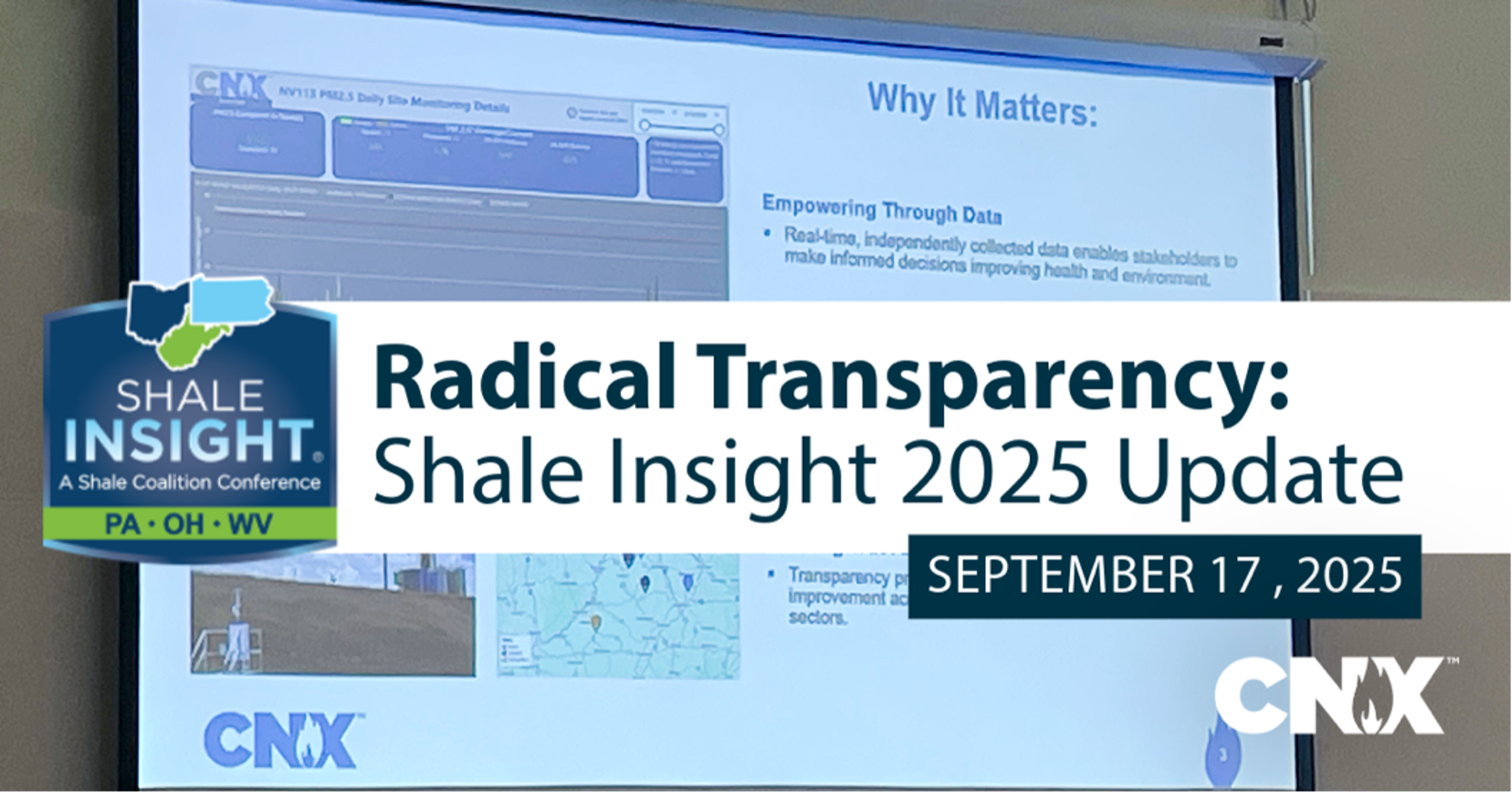
By Positive Energy Hub Staff
Carrie Crumpton, Vice President of Environmental Strategy, presented on behalf of CNX at the 2025 Shale Insight Conference. Carrie provided an overview and update on CNX’s Radical Transparency initiative during the “Clearing the Air: An Update to Public-Private Air Quality Monitoring Commitments within the Appalachian Basin” session. The following is a summary of Carrie’s remarks.
Good afternoon and thank you for the introduction.
Radical Transparency is changing the way environmental data is shared and understood in shale development. CNX first launched this initiative in November 2023, driven by a straightforward purpose: provide real-time, site-specific air quality data from our operations. Rather than relying on inference and statistical models, we chose to deliver objective measurements—data that communities, policymakers, and researchers can trust.
Why Radical Transparency Matters
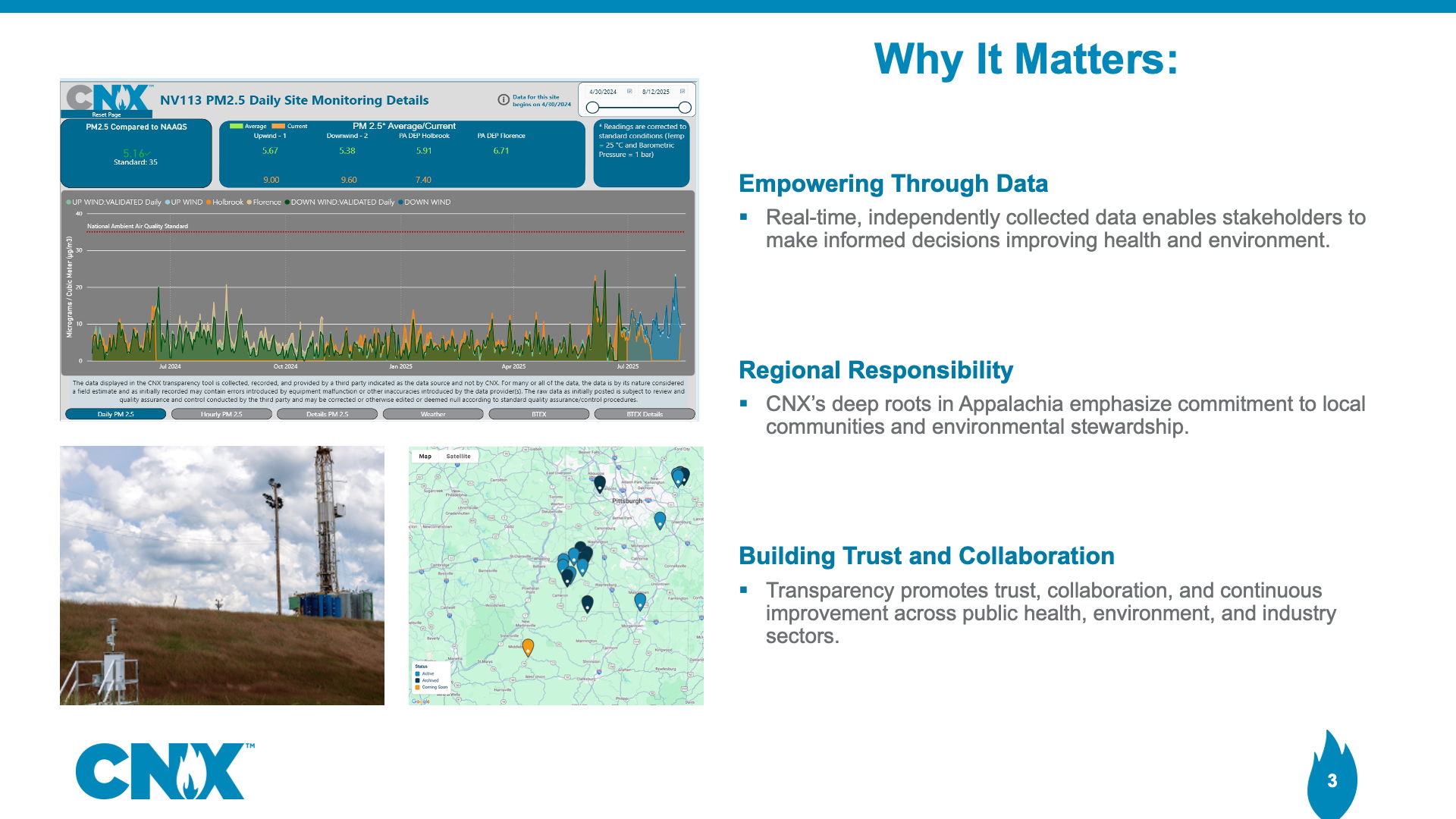
Facts are crucial for public health, environmental protection, and they are best captured directly at the source.
CNX has deep roots in Appalachia. We’ve been part of the Region since the mid-1800s. And our responsibility to the communities where we live and work is something we take seriously.
Radical Transparency is our approach to advancing sound research around natural gas development. Instead of relying on retrospective studies and statistical associations, we offer real-time, independently collected data—publicly available and easy to use. It can be used by residents, by industry for actionable insights, by the scientific and medical community, and by government/agencies for public policy purposes. We encourage it. Pennsylvania DEP and Governor Shapiro saw its potential and joined CNX as key partners.
A defining feature of the program is that DEP receives raw air quality data simultaneously with CNX. This ensures data integrity from both technical and public perception standpoints, strengthening the first-of-its-kind public-private collaboration.
Program Components
Radical Transparency is the most comprehensive program of its kind anywhere in the country. The program includes:
- Air quality monitoring
- Additive disclosure
- Water quality monitoring
- Radiation protection
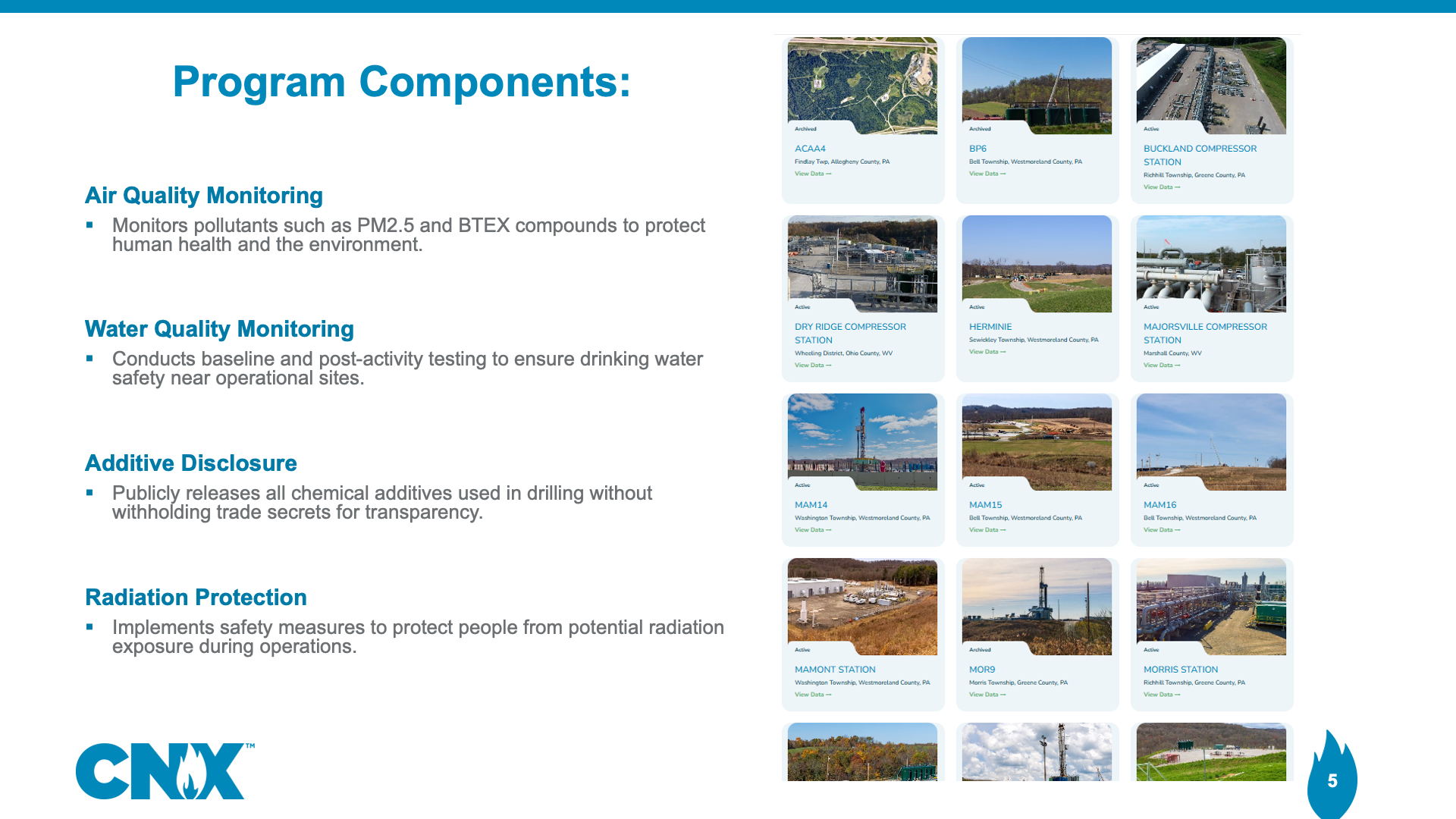
For today’s update, I’ll focus on the air and water quality portions. These components are designed to monitor the emissions and impacts most likely to affect human health and environmental integrity.
For air quality, we focus on:
Radical Transparency monitoring follows CNX’s activity plan. Where we operate, so too does Radical Transparency, covering the development process of site construction, drilling, completions, and start of flowing production where our activities are most intense and the most logical application for continuous, and targeted monitoring.
To avoid any subjectivity in the site selection process, we continuously monitor all major midstream locations, and then every new major production facility from the beginning of the construction phase through six months of the production phase.
This approach ensures that we prospectively monitor 100% of our locations with development phases that have the highest intensity of emissions related activity.
There is no “cherry-picking”—monitoring simply follows our operational schedule.
For water quality, CNX has expanded monitoring of private drinking water within 2,500 feet of a well bore by conducting four quarterly samples before and after drilling, exceeding regulatory and industry standards.
Best practices include:
- Baseline testing for pH, conductivity, total dissolved solids, methane, chloride, and heavy metals before work starts.
- Multiple layers of steel casing and cement barriers provide well integrity and prevent fluid migration.
- Avoiding sensitive aquifers using geologic modeling in drilling plans.
- Monitoring for at least a year after activity to detect any delayed impacts.
- Advance disclosure of all chemical additives anticipated for use, a first-of-its-kind commitment to full transparency.
How We Monitor
Since launching the program, we’ve conducted monitoring at 18 sites across our operational footprint. These include major midstream locations and new production facilities, monitored from the start of construction through six months of production.
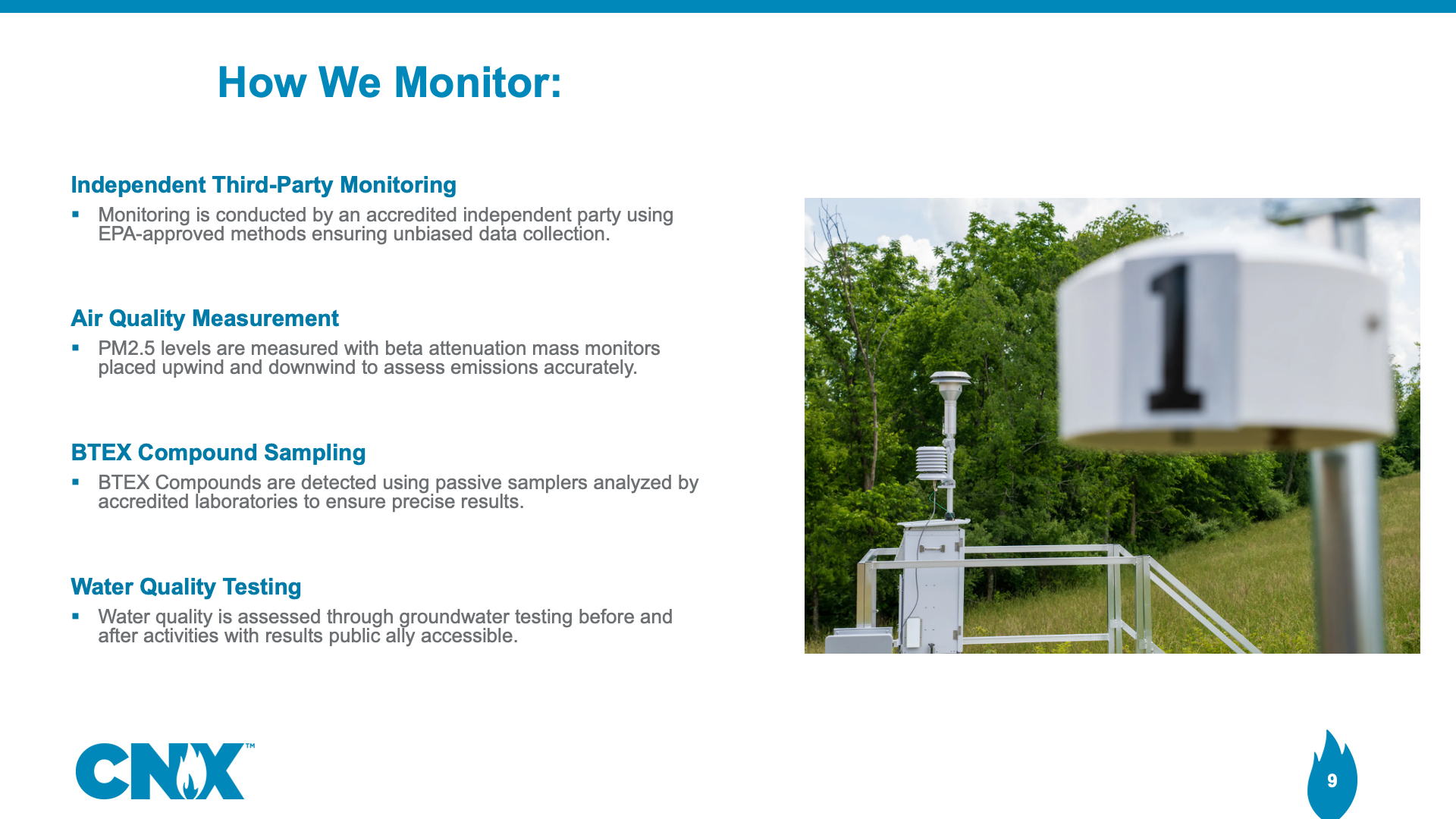
Monitoring is conducted by an independent, accredited third party, using EPA-approved methods and a defined quality system. Some of the findings from these efforts will be shared this afternoon.
For PM2.5, each site gets two real-time beta attenuation mass monitors—one downwind for emissions and one upwind for background levels. The difference reveals the site’s incremental contribution.
BTEX measurements come from passive, time-integrated samplers arranged in four quadrants around each site, following EPA Method 325. Samples are analyzed by an accredited lab using Method 325B.
Water monitoring features pre- and post-activity groundwater tests, with results released publicly, subject to landowner consent. This includes testing for common indicators of contamination and comparison against health-based standards.
Data Transparency
Data flows to a secure cloud platform for reporting and visualization and is posted to a public dashboard on the CNX website, alongside nearby DEP monitor readings and health standards.
- PM2.5 is compared to the National Ambient Air Quality Standard (NAAQS).
- BTEX to the Agency for Toxic Substances and Disease Registry (ATSDR) inhalation Minimum Risk Levels.
- Water results to EPA drinking water standards and other health-based benchmarks.
Ensuring integrity, air quality data is made available at the same time to the DEP by the third-party collector. To date, about 700,000 data points have been collected, with those growing rapidly as monitoring continues around the clock.
Internally, CNX uses this data to spot trends, refine operations, and reduce emissions. Externally, the Pennsylvania DEP uses Radical Transparency to launch greenfield site monitoring, which will continue through the site’s full development—providing independent validation of the program’s value and reliability. Background air quality monitoring at this location began earlier this year.
Key Findings
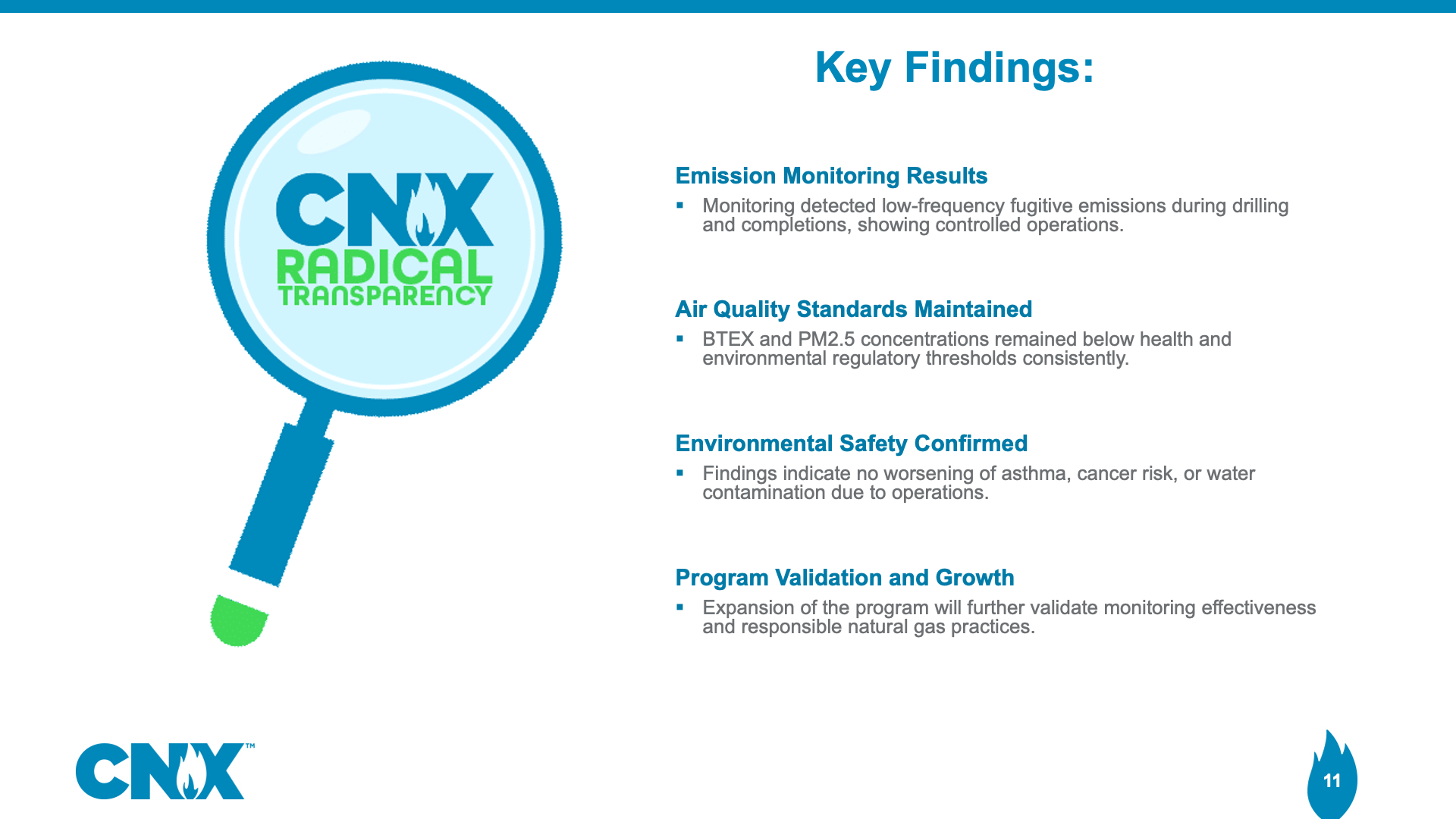
From the past almost two years, Radical Transparency has revealed:
- Low-frequency fugitive emissions during drilling and completions
- BTEX at background levels, never exceeding ATSDR thresholds
- No PM2.5 exceedances under EPA standards
In short, we’ve found no evidence of impacts that would exacerbate asthma, cause cancer, degrade local air quality, or contaminate drinking water. And as we expand the program, we expect these findings to be reinforced.
Data also informs the debate on setbacks in natural gas operations. Every new data point helps clarify what is truly needed—facts replacing fear. As we approach collecting nearly a million data points, the evidence does not support additional setback expansions.
Moving Forward
CNX encourages others in the industry to follow our lead, adopt similar approaches, and commends those expanding their own data transparency, including those here with me today. More data means deeper insights and stronger conclusions.
We’re also calling on the scientific community to engage with this data. Real-time measurements offer a superior foundation for analysis, and universities have a role to play in reconciling these findings with existing statistical records.
From a policy perspective, we now can base future regulations on actual measured data—not speculation or assumptions lacking scientific validation.
Combined efforts will help build a comprehensive, real-time environmental monitoring platform that supports public health, informs policy, and drives continuous improvement across the industry.
Radical Transparency has improved CNX, cut emissions, and lowered risk. Most importantly, it helps us protect the communities and environment where we operate.
Through this collaboration with the Commonwealth, we’re proving every day that natural gas development and environmental protection can and do co-exist.
We’re proud of what we’ve built—and we’re just getting started.
You may also like...



